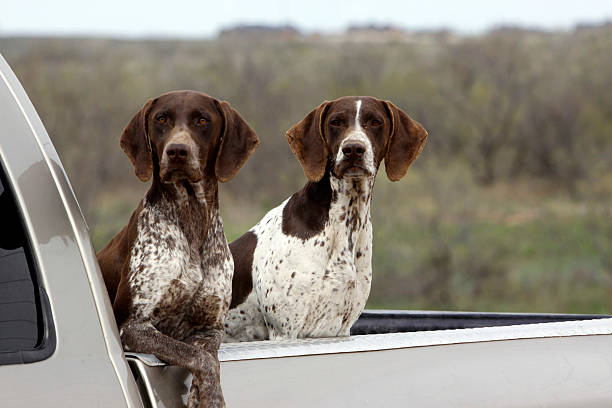German Shorthaired Pointer (GSP)

Breed History:
The German Shorthaired Pointer (GSP) was developed in Germany during the 17th to 19th centuries as hunters sought to create a truly versatile gun dog—one capable of pointing, retrieving, tracking, and even handling waterfowl and large game across varied terrain. Influences include Spanish Pointers, Bloodhounds, and local German hunting dogs.
By the mid-1800s, the foundation for the GSP as we know it today was firmly established. Unlike more specialised British gundogs, the GSP was bred to do everything in one body, making it the ideal choice for hunters who needed a single dog to work fields, forests, and lakes. The breed quickly earned a reputation for unmatched adaptability and endurance in the field.
The GSP was officially recognized by the German Kennel Club in 1872, and the first studbook entry was a dog named "Nero." The breed was introduced to the United States in the 1920s, where it quickly became popular for both sport and companionship. It’s now one of the top-ranking sporting breeds globally, used in hunting, search and rescue, detection work, and as a beloved family dog.
Considering adopting a pointer breed? Check out our page "How to look after a Pointer" detailing what to consider before adopting and our recommended products.
|
Gender |
Height |
-Weight |
|
Male |
58-64 cm |
25-32 kg |
|
Female |
53-59 cm |
25-32 kg |
Size – Medium-sized dog
Life Expectancy: 12 to 14 years

Breed Appearance:
The German Shorthaired Pointer is a sleek, athletic dog with a muscular build and clean lines. It has a noble head, dark eyes, and broad, floppy ears. The tail is often docked in working dogs (where legal) and held horizontally when alert.
Its short, dense coat is water-resistant and comes in liver, liver and white, ticked, patched, or roan. The breed’s powerful build and graceful movement reflect its strong working instincts.
Breed Type – Family/Hunting:
German Pointers are classic working dogs, bred for both sport and companionship. All three coat types share a loyal, affectionate nature, thriving on human interaction and forming deep bonds with family members. They are known to be excellent with children and typically friendly with other dogs.
While highly driven and prey-oriented, they are not aggressive. Their sociability and enthusiasm make them poor guard dogs but wonderful companions in active homes. They excel in hunting, field trials, and even agility, obedience, and scent work. Despite their heritage, they adapt well to home life, provided they get sufficient physical and mental stimulation.

Training:
Very trainable and eager to please, the GSP thrives on structure and purpose:
-
Quick to learn, especially with positive reinforcement
-
Needs early socialisation to curb overexcitement
-
Responds well to clear commands and consistency
-
Highly motivated by praise, play, and food
-
May become distracted by scents if not focused
Training should include recall, leash control, and mental games.
Health & Care:
A generally healthy breed, but monitor for:
-
Hip dysplasia
-
Bloat (gastric torsion)—due to deep chest
-
Progressive retinal atrophy (PRA)
-
Heart conditions
-
Ear infections, especially in active swimmers
Feed a balanced, high-energy diet, and ensure regular vet checkups.

Living Conditions:
Not well-suited for sedentary or small-space living:
-
Best in homes with fenced yards or access to open areas
-
Thrives with active families, hunters, or outdoor lovers
-
May become destructive or anxious if under-exercised
-
Needs companionship and mental stimulation
Works well in rural and suburban settings or with owners who are regularly outdoors.
Exercise:
Extremely high energy:
-
Requires 2+ hours of daily activity
-
Needs running, swimming, fetching, and scent-based play
-
Great for canicross, agility, field trials, or dock diving
-
Not suited to long periods of inactivity
Without enough outlets, GSPs may bark, dig, or chew from boredom.
Grooming:
Low-maintenance grooming:
-
Weekly brushing removes dead hair and stimulates skin
-
Bathe occasionally—coat is self-cleaning
-
Clean ears regularly (especially after swimming)
-
Trim nails and brush teeth routinely
The breed sheds moderately year-round, despite the short coat.

Advantages:
-
Highly intelligent and trainable
-
Versatile—excellent at hunting, sports, and family life
-
Affectionate and loyal to family
-
Great with children and other pets (with socialisation)
-
Sleek, low-maintenance coat
-
Eager to work and please
Disadvantages:
-
Needs very high daily exercise
-
May become hyperactive or destructive without stimulation
-
Not ideal for apartments or inactive owners
-
Strong prey drive—may chase small animals
-
Can be overly excitable if not trained early
-
Prone to separation anxiety if left alone too long

